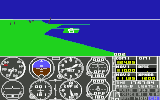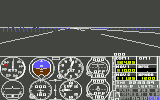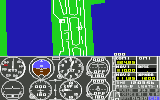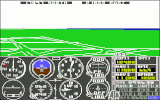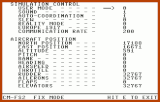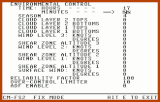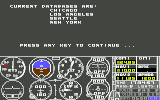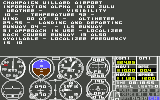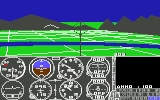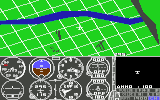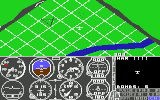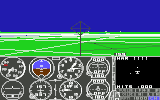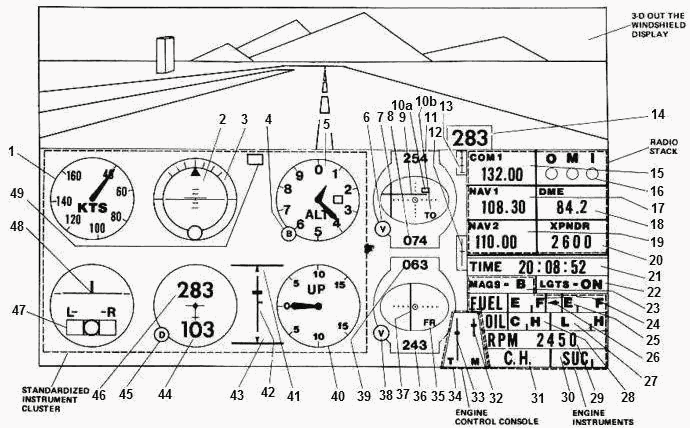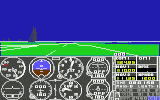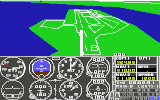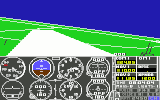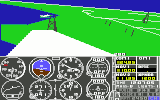Flight Simulator II
| Flight Simulator II | ||
|---|---|---|
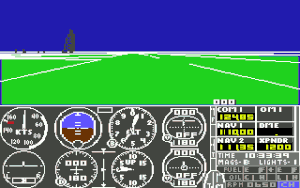 | ||
| Game No. | 327 | |
| Voting | 7.12 points, 17 votes | |
| Developer | Bruce Artwick | |
| Company | subLOGIC | |
| Publisher | subLOGIC | |
| Release | 1984 | |
| Platform | Amiga, Apple II, Apple MacIntosh, Atari 8-bit, Atari ST, C64, MSX (torpedo attack), PC, TRS-80 (nur FS I) | |
| Genre | Simulation, Flight (Civil) | |
| Gamemode | Single player | |
| Operation | ||
| Media | ||
| Language | ||
Description[edit | edit source]
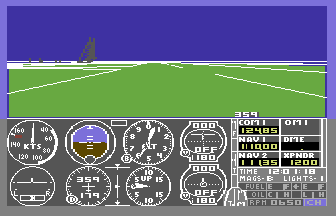
The "Flight Simulator II" (FS2) for the Commodore 64 was released by the company subLOGIC in 1984, one year after the first version for the Apple II, in which the graphics were practically the same except for some slight differences. There was a version on tape and one on disk. Enclosed was a 90-page manual "Pilot's Operating Handbook and Airplane Flight Manual", a 92-page book about aeronautics, four flight maps and a double-sided "Quick Reference" map.
The FS2 is more than a game, it offers many characteristics of a real flight simulation. It simulates the Piper PA-28-181 Archer II (a single-engined, 148 mph fast machine without retractable landing gear) and is equipped with all essential instruments, so that also an IFR is possible. For navigation you have several radios available with which beacons can be located. The reliability of the plane can also be set.
For operation you use the keyboard. All commands can either be entered with a single press on the button or with CONTROL + key. SHIFT does not play any role. Optionally you can also plug in one to two joysticks, the one in port1 to control the plane, the one on port 2 to accelerate or brake.
Through his window, the pilot looks onto a quasi 3D landscape, in which he can move freely with his plane. It contains lakes, mountains, streets, some (few) buildings and of course landing runways. There are nine views available: next to forward, backward, right and left these are also the diagonals (e.g. front left) and a view downwards. A "radar" mode makes it possible to recognize the plane's position in the surrounding.
The simulated world contains day and night, two layers of clouds and four wind levels. The standard scenery does cover the whole of USA (without Alaska and Hawaii), but only 4 areas with data: Chicago, Seattle, Los Angeles and New York/Boston. Contained are 80 airports, with ATIS and a series of runways with ILS as well as a list of beacon frequences (VOR, NDB) and the coordinates of some sights. In the folllowing years a series of subLOGIC Scenery Disks was released that did not only contain the whole of USA (without Alaska), but also parts of Europe and Japan.
In order to be able to move faster and easier in the scenery, the FS2 contains a "SLEW" mode, in which the current coordinates are displayed at the top of the screen.
This mode can be entered into the editor menu, same as 35 other parameters (e.g. for flight coordinates, height, direction, clouds, wind,...). If you set AUTO-COORDINATION = 0 and REALITY-MODE = 1, the simulation will get more real, but also considerably more difficult. A mode that has been created in the editor menu can also be saved and loaded again. Nine values for the modus parameters are fixed, the others can be used, i.e.:
Mode Description
0 Easy flight mode 1 Realistic flight mode, good weather 2 Demonstration mode 3 Los Angeles Int.: flight during dawn 4 Night flight (Meigs Field) 5 Flight during moderate weather (New York JFK Intl.) 6 Bad weather flight (Boston Logan) 7 1st World War flying ace - Game 8 Horizontal Situation Indicator (Champaign Willard) 9 (Champaign Willard) 10-19 User modes or alternated preset modes
20-24 User modes
With choosing "EUROPE 1917" = 1 in the editor a game starts against a computer enemy, in which you need to fight against 6 planes and destroy hostile factories and fuel storages with bombs. For destroying a factory you get 20 points, for a fuel depot 10.
-
Approach towards Meigs Field
-
Night flight
-
"Radar" view on Meigs Field
-
Bad weather in Boston in the SLEW mode
-
Editor page 1
-
Editor page 2
-
The scenery info (after CTRL E)
-
Champaign ATIS messages
-
WW1 - view onto the river
-
WW1 - the base in the radar
-
WW1 - war! enemy territory in the radar
-
WW1 - hostile jets
Design[edit | edit source]
The screen[edit | edit source]
The screen is divided into two in the flight or SLEW mode: the upper half shows the view onto the surrounding, the lower contains the instruments. At the top they worked in the multi-colour mode with 4 colours, which are different at night than during the day time. If you look at the sides, you notice that a wing is visible as a white trapeze, at the back the helm is visible as a white vertical stripe. In the lower part of the screen the hires mode is used to reach the necessary resolution for the display. The instruments react instantly on changes and by this give a quite realistic image.
The world[edit | edit source]
The "world", in which you fly, has a size of 10.000 to 10.000 miles with a resolution of about 2,5 ft. and the center approx. 30 miles southwest of Champaign, Illinois. Airports and other details were saved directly from air photographs. The FS2 world is flat, mountains are drawn as objects with polygons onto this plain. Each place is marked with NORTH and EAST coordinates, which have nothing to do with the lines of longitude and latitude of the real world. A change of 1 corresponds to 256 meters. With this only a rough positioning can be reached with the editor, if necessary, you need to correct with the Slew mode.
Sound[edit | edit source]
Compared to the beep sound of the PC boxes at that time, the motor sound of the FS2 at the C64 is done quite acceptably, but a bit monotonuous. Different sounds can be heard in special situations (landing, crash, approach with ILS). The sound can be switched off or on in the editor with the values "0" or "1".
Hints[edit | edit source]
The instruments[edit | edit source]
1. Airspeed indicator (knots) 24. Fuel display gauge
2. Artificial horizon 25. Fuel display gauge
3. Bank scale (not simulated on C64) 26. Arrow for fuel choice
4. Altimeter calibration 27. Oil pressure gauge
5. Altimeter 28. Oil temperatur gauge
6. Button for bearing options 29. Digital tachometre
7. Deviation display 30. Underpressure indicator
8. Reciprocal course set pointer 31. Carburetor heating
9. Volplane needle 32. Mixture control unit
10. a) Volplane flag 33. Throttle lever
10. b) To-From-Off flag 34. Motor controls unit
11. Course adjustment 35. To-From-Off flag 2
12. Pitch elevator trim indicator 36. Reciprocal Course display 2
13. Landing flap indicator 37. Deviation display 2
14. Magnet compass 38. Button for bearing options 2
15. COM (communication) radio 39. Course adjustment
16. Outer, middle, inner beacon 40. Vertical speed indicator
17. NAV (Navigations-) radio 41. Aileron control
18. Distance indicator in nautic miles 42. Elevator control
19. NAV radio 2 43. Rudder control position indicator
20. Transponder 44. Course reciprocal display
21. Clock 45. Magnet compass calibration button
22. Lights on/off display 46. Course indicator
23. Magneto display 47. Slip display
48. Spirallling indicator
49. Stall warning light
Commands for steering the FS2[edit | edit source]
A list of all the commands in FS2 would go beyond the scope of this article. Therefore, only a short overview over the most important key combinations is given here. A full reference can be found under Links - Documentation.
FLIGHT CONTROLS AND CHECKS
F, H aileron left, right or joystick 1
(on the ground: steering left, right)
B, H elevator up, down or joystick 1
G centre up, stops change
], [ more, less gas (16 Steps) or joystick 2
Space key brake
5R, 5T, 5Y look forwards left, straight, right or joystick 1 with fire
5F, 5H look to the left, right or joystick 1 with fire
5C, 5B, 5V look backwards left, straight, right or joystick 1 with fire
5G look downwards
4, 5 switch radar on, off
<<<, >>> radar zoom out, zoom in (after 4)
P pause, end with any key
CTRL L lights on/off
+ reloads current mode
E switch on/off editor display
CTRL E shows the current flight areas,
now a new scenery disk can be inserted.
SLEW-MODE (is switched on/off in the editor)
T, B, F, H to north, south, west, east or joystick 1 R, Y tilt to the left, right V, N turn to the left, right G stops changes Z viewing angle reset: pitch, heading, bank = 0
EDITOR (is switched on/off with E)
RETURN confirm input/to the next issue - to the previous value ARROW-LEFT corrects previous character S saves the current flight parameters in the mode library
EUROPE 1917 (is started in the editor)
W declares war (until then you can do reconnaissance flights without being bothered)
R report (success and damage report)
X throw bomb (max. 5)
SPACE machine gun (if in the air) or joystick 1 fire
or respectively brake (on the ground)
Solution[edit | edit source]
A first flight[edit | edit source]
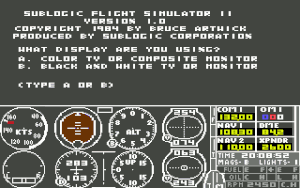
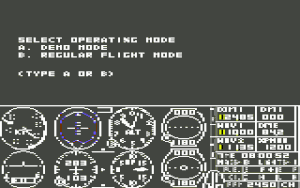
We put the FS2 disk into the drive and load the programme with LOAD"*",8,1 - RETURN. The border colour changes and loading takes - as shown - 2:40 minutes. Unfortunately, the FS2 does not work with a floppy speeder, so you will need patience here. If you use the emulator VICE, however, you can use the warp mode with Alt +W ; but be careful: switch it off before you make the next input! After some time the display menu appears. Here press A . Next choose the regular flight mode with B in the menu "Operating Mode". Now it takes only a small while and then you are on the airport Meigs Field in Chicago with the Piper Archer.
We only use the keyboard, as the FS2 can be controlled more precisely with it than with the joystick, due to the rather slow reaction times. The reality mode is default set to "0", so we can simply accelerate and start flying. For this press the ]; several times until the accelerator goes no further - you can see this on the engine console at T(hrottle). The hand on the speed indicator (KTS) moves. When it is above 80, pull the elevator: press B twice. Now the bird gently lifts, the nose goes up and at the front you see nothing more than the sky. So we throw a glance behind us: press 5 and then B . We can see Meigs Field in the "rear mirror". Due to the slow frame rate of only about 1/sec. the movement is only jittery, but we are flying! Lets look to the left: press 5 and then F . Our left wing gets visible and the diagonal horizon shows the position of the plane.
After a while the "Sears Tower" appears at the left - or respectively the grid graphics that is supposed to represent it. When we have passed it, we take a turn to the left. For this press the key F once or twice and then quickly G again, before the plane tilts too much to the left. The movement can be followed well on the instrument with the artificial horizon. The plane takes a left turn and slowly rolls back to its original position. Maybe we repeat the last manoeuvre, so that we finally fly on the opposite course, the compass at the top should read about 180°. This will probably not work precisely on the first try, but that doesn't matter.
As soon as the Piper flies straight again, we try to keep a constant height. For this, we throttle the motor a bit: press [: several times. Now wait and see how the machine reacts. Meanwhile we watch the altitude indicator (ALT) and the artificial horizon. If we are still rising too much, we take back the elevator with the key T pressed once. It is not so easy to keep the plane on a stable course at a constat height.
This should be enough for the beginning - you return to the start with + , which reloads the mode. If you want to you can of course go on flying - have fun!
-
Takeoff in Meigs Field
-
Looking back
-
The Sears-Tower on the left
-
Left turn
Cheats[edit | edit source]
Voting[edit | edit source]
| Voting of the C64-Wiki users (10=the best vote): | ||
| 7.12 points at 17 votes (rank 423). You need to be logged in to cast a vote. | ||
| C64Games | 8 | 9th January 2010 - "Super" - 5.040 downs |
| Lemon64 | 7,6 | 9th January 2010 - 19 votes |
| Kultboy.com | 6 | 26th June 2011 - 1 votes |
Reviews[edit | edit source]
Petrus: "If you want to have fun with FS2, you need patience, an interest in flying in general and the willingness to read a manual carefully. For many people this is a reason to abandon it with frustration or boredom, which I can absolutely understand. But if you get into the simulation, you can have fun for years. A whole troop of 'flightsim' fans has made the first experiences on the C64 with the FS2. I am still today fascinated by the programme. Conclusion: This game is a classic."
H.T.W: "A fascinating piece of software and at the same time the probably most sophisticated and with the subLOGIC Scenery Disks also the most comprehensive flight simulator for the C64. However, the programme is rather complex and you have to familiarize with the material. So nothing for in between, but if you know the Piper Pa 28-181 Archer II and her instruments and flying characteristics after numerous crashes, you have a huge terrain available that wants to be explored. A must for patient people that like spending time with simulations."
Miscellaneous[edit | edit source]
- Marginal trivia: Meigs Field, the standard airport in FS2 and the many following simulations, does not exist any more since 2003. At its place you find today the Northerly Island Park.
Cover[edit | edit source]
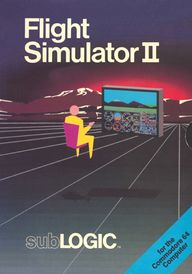
Bugs[edit | edit source]
- If the Reality mode is enabled, the engine stops when leaving the Editor menu to resume flight.
- Three out of the four Instrument Landing Systems (ILS) available in the default scenery are not accurately aligned with the asociated runway. The affected ILS localizers are offset from the runway center line by up to 2°. Only the alignment of Van Nyus ILS 16R is correct.
- On European C64 computers, the simulation runs 20 percent slower than real-time speed. Consequently the airplane appears to react sluggishly and flight progress is slower than shown on the airspeed indicator. For the latter reason, navigation parameters like ground speed, wind speed and estimated time of overflight cannot be correctly determined.
Highscore[edit | edit source]
No highscore possible in this game
Links[edit | edit source]
| Simulator II Wikipedia: Flight Simulator II |
Download:
- C64Games.de - Game No. 1084
 also contains documentation (commands, airport directories, maps etc.)
also contains documentation (commands, airport directories, maps etc.) - Lemon64 - Game No. 3176 at lemon64
- Gamebase64.com - Game No. 2810
Documentation:
- CM-FS2 Flight Reference Card
- FS2 commands reference
 (text file)
(text file) - Manual for the C64-Version
 in Internet Archive (bad quality, but the only source)
in Internet Archive (bad quality, but the only source) - Handbook (Atari)
 "Pilot´s Operating Handbook and Airplane Flight Manual"
"Pilot´s Operating Handbook and Airplane Flight Manual" - FlightSimBooks

- 40 Great Flight Simulator Adventures
 in Internet Archive
in Internet Archive - 40 More Great Flight Simulator Adventures
 in Internet Archive
in Internet Archive
Reviews:
- 64'er
 project 64'er 84/07
project 64'er 84/07 - Test Report No. 1808 on Kultboy.com

- Flight Simulator II by John S. Davison, Atari
- Flight Simulator II v. 1.05 at Atari 8-bit Forever]
FS-History:
- FSII History by Jos Grupping
- The Old Flight Simulator Vault by Jos Grupping
- Czech Flight Simulator History Website with video
